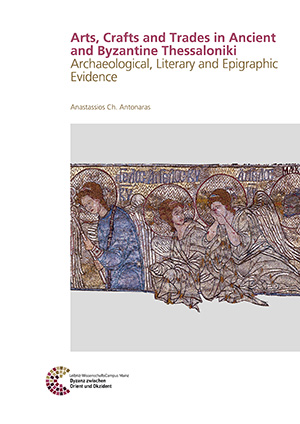Byzanz zwischen Orient und Okzident
Der ScienceCampus – Byzantium between Orient and Occident – Mainz / Frankfurt is a joint research venture between the Leibniz-Zentrum für Archäologie, the Johannes Gutenberg University Mainz, der Goethe-University Frankfurt and the Leibniz Institute of European History. The aim is to institutionally establish a broad platform for interdisciplinary Byzantium research. Participating are beside Byzantine studies, Christian archaeology and Byzantine art history, all subjects that make a contribution to the research of the Byzantine Empire and its culture. The ScienceCampus Mainz / Frankfurt promotes the integration of the fragmented scientific disciplines that deal with Byzantium. It enables theme-oriented, multidisciplinary, historic-cultural research consolidated under one umbrella and improves the visibility of the subject area through a joint appearance of Byzantine research.
The series “Byzantium between Orient and Occident” serves as publication organ for the research programme of the Leibniz ScienceCampus Mainz/Frankfurt that studies Byzantium, its role as bridge between East and West, and cultural transfer and reception processes from Antiquity to modern times. The methods and research subjects of the various disciplines dedicated to Byzantium are brought together across traditional disciplinary boundaries in order to take a comprehensive historical and cultural approach to research into Byzantium and its material and immaterial culture.

Contact
Leibniz-WissenschaftsCampus – Byzanz zwischen Orient und Okzident – Mainz/Frankfurt
Dr. Benjamin Fourlas
Leibniz-Zentrum für Archäologie
Ludwig-Lindenschmit-Forum 1
D-55116 Mainz
E-Mail: fourlas@rgzm.de
Internet: Homepage
Published so far
Schiffe und ihr Kontext: Darstellungen, Modelle, Bestandteile – von der Bronzezeit bis zum Ende des Byzantinischen Reiches
Seafaring was extraordinary important in Antiquity and the Middle Ages for the economy and the wielding of power. It also provided contact between distant places. Ships were on the one hand decorated and ornamented and on the other hand they were frequently objects of depictions which could range from sketchy graffiti to three-dimensional reproductions. The contexts of the depictions encompass different areas, such as public and private representation as well as religion.
This Volume assembles 18 articles that have been presented on the occasion of an international workshop in 2013. Different groups of material ranging from the period of Bronze Age until the end of the Byzantine Empire were presented as well as the development of ship-building and navigation. The depictions of ships which have investigated scanty until now were the main target of the workshop.
Die byzantinischen Häfen Konstantinopels
The fortunes of Byzantine Constantinople always have been intrinsically tied to the sea. Topographical, demographical and economical development of the city is reflected in the history of its harbours, which for the first time is concerned in its entirety in this volume.
Twelve studies regarding the harbours and landing places of the city at the Sea of Marmara and the Golden Horn – but as well regarding those in their European as in their Asian surroundings – are creating a synthesis of the current state of research by analysis of written, pictorial and archaeological sources.
Arts, Crafts and Trades in Ancient and Byzantine Thessaloniki: Archaeological, Literary and Epigraphic Evidence
For the first time, the arts and crafts of Thessaloniki, once the second largest city in the Byzantine Empire after Constantinople, are examined thoroughly through archaeological remains, historical sources and epigraphic records.
More than 80 years of archaeological research and a life-time of personal research that covers 112 excavations, reveals at least 16 artisanal trades in detail. The book is organised chronologically with overviews of the political history and topography of Thessaloniki throughout its nineteen-centuries-long history. With an illustrated catalogue of each site and distribution maps, this work reveals relatively unknown aspects of life in Antiquity, the Early Christian period and Byzantium.
Slightly revised new edition of Anastassios Ch. Antonaras: Arts, Crafts and Trades in Ancient and Byzantine Thessaloniki Archaeological, Literary and Epigraphic Evidence of 2016
Arts, Crafts and Trades in Ancient and Byzantine Thessaloniki: Archaeological, Literary and Epigraphic Evidence
For the first time, the arts and crafts of Thessaloniki, once the second largest city in the Byzantine Empire after Constantinople, are examined thoroughly through archaeological remains, historical sources and epigraphic records.
More than 80 years of archaeological research and a life-time of personal research that covers 112 excavations, reveals at least 16 artisanal trades in detail. The book is organised chronologically with overviews of the political history and topography of Thessaloniki throughout its nineteen-centuries-long history. With an illustrated catalogue of each site and distribution maps, this work reveals relatively unknown aspects of life in Antiquity, the Early Christian period and Byzantium.
There was a new edition of Anastassios Ch. Antonaras: Arts, Crafts and Trades in Ancient and Byzantine Thessaloniki Archaeological, Literary and Epigraphic Evidence 2019
Der Doppeladler: Byzanz und die Seldschuken in Anatolien vom späten 11. bis zum 13. Jahrhundert
The Rum Seljuk Empire had emerged after the devastating Battle of Manzikert in 1071 in the previously Byzantine Anatolia. Until its dissolution in early 14th century it was the Byzantines’ most important neighbor on their Eastern border. The Rum Seljuk Empire combined Seljuk and Greek-Orthodox populations. Thus it was in close contact with Byzantium: Especially trade, the exchange of artists and marriages defined these relations. These social and political links as well as the ethnic and religious tolerance that shaped the coexistence of different groups in the Rum Seljuk Empire built the foundation for great art. At the same time we only know little about the Rum Seljuks and their interaction with the Byzantines so that the impression, that there had not been any cultural exchange between them, still prevails.
This conference volume presents the results of an interdisciplinary congress that took place October 1.-3, 2010 in the Römisch-Germanisches Zentralmuseum Mainz. The congress intended to discard this impression and initiate a discussion about problems concerning the Byzantine-Seljuk relations.












